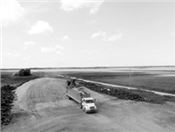|
Silage Piles Save Money Over Baleage On Late-Planted Corn
COLUMBIA, MO.
The cost to harvest corn planted as a cover crop for silage this year varies greatly, according to a new study from University of Missouri Extension.
USDA Risk Management Agency allows producers to harvest cover crops, including corn, from prevented-plant acres beginning Sept. 1 this year without losing crop insurance subsidies. According to USDA Farm Service Agency, nearly 1.4 million acres of Missouri cropland went unplanted this spring due to wet weather and flooding.
RMA changed the date to begin harvest from Nov. 1 to Sept. 1 this year due to historic flooding and rains. This earlier deadline allows growers an opportunity to ensile late-planted corn to feed livestock, says Reagan Bluel, MU Extension dairy specialist.
The traditional “chop-pile-cover” method costs about half as much as baleage, according to a team made up of Bluel, ag business specialist Brent Carpenter and specialist Ryan Lock. They looked at different harvest and storage methods and considered costs for planting to storage for varying yields. This reflects “as fed” costs typical for silage. Because silage is 2/3 water, dry matter costs are significantly greater, Carpenter says.
Whatever the method, ensile corn at 65 percent moisture to ferment properly, Bluel says. Proper fermentation results in increased feeding value to your herd.
Corn planted in July may not reach the stage when moisture levels are prime for ensiling. For best results, collect well-mixed samples to test moisture content.
Using a Koster tester or a microwave oven are two common ways to test moisture. For details, download the MU Extension publication “Using a Microwave Oven to Determine Moisture in Forages” at extension.missouri.edu/p/G3151.
Silage pile
Preparation is key to the silage pile method, says Bluel.
Consider where you will feed the silage before you begin harvest. Under the “chop-pile-cover” method, equipment chops and blows forage into a truck or wagon to haul. Silage contains 65 percent water, so you do not want to haul it a long way before or after ensiling.
Pack piles tightly to get rid of oxygen pockets that spoil feed. Bluel says research from Cornell University shows losses of up to 20 percent from underpacking. Select a site with good elevation and drainage. Put the pile near feeding systems and protect it from rodents and other animals that could damage the plastic cover.
Order cover plastic in advance. Figure the size of the silage pile and order enough 6-mil plastic to cover immediately after packing to reduce storage loss. Weigh down the plastic with old tires and seal along the edges.
This option costs about $25-$45 per ton into storage as fed ($70-$130 dry matter basis), says Carpenter.
Baleage
Baleage involves mowing, wilting, round baling and wrapping in plastic to get rid of oxygen. Ensiling happens in the long white tubes you might see at the edge of fields. The round baler does the packing needed in the traditional silage process.
“Mow only what you can bale and wrap within 24 hours,” says Bluel. “Remember forage needs moisture to ensile, and depending on the density of the corn and weather, moisture can change in the windrow pretty quickly.”
Swath corn the width of your baler to avoid raking; field wilt immature corn to the right moisture for ensiling. Lush, immature corn could be 80 percent water, which would be too wet to ensile, she says.
Wrap bales with two layers of net wrap and seven layers of 1-mil plastic film. Do not skimp on plastic; wrap bales airtight. If oxygen enters, the forage molds. Check bales often and seal holes with plastic tape.
Carpenter says the cost for this method is about $55-$70 per ton as fed ($155-$200 dry matter basis), making it a convenient but expensive option.
Proper chop improves feeding efficiency
Silage balers with crop-cutting knives improve the consistency of cattle feed. The knives chop stalks and cobs into small parts to blend the best part of the corn with the worst, says Bluel. This reduces waste because cattle do not have the option to eat just the best parts and leave the rest.
“It’s like us eating a Snickers bar and not eating the green beans,” says Bluel. “We want the cow to have a balanced ‘biteful’ so the cow cannot sort out the candy.” ∆

Used tires provide weight to secure plastic around the silage pile.
Photo courtesy of Rana Zeller

Trucks bring chopped corn to a central location for packing, covering and ensiling.
Photo courtesy of Rana Zeller
|
|